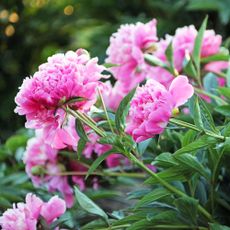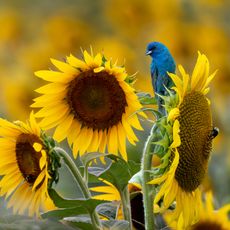How To Turn Your Garden Into A Certified Wildlife Habitat
You can make your garden an official haven for wildlife. Here's how.


I’ve often watched the squirrels cavort around my garden or the birds feasting on my grapes and wondered what it would take to get one of those certified wildlife habitat signs. I think I’ve got food, water, shelter and nesting sites covered so what else do I need to become a certified wildlife garden? If you too are interested in how to create a certified wildlife garden, keep reading to learn all about wildlife habitat certification.
What Is a Certified Wildlife Habitat?
A certified wildlife habitat means your landscape is a safe haven for local wildlife. This means your landscape must have water sources, various food and nesting materials, and protective cover. Certification is granted by the National Wildlife Federation.
Benefits of Creating a Certified Wildlife Habitat
There are numerous benefits to creating a certified wildlife habitat, not the least of which is knowing that you are doing your part to help protect endangered species. Land development and other changes are forcing out native plants, animals and birds by removing their habitat.
A wildlife garden not only restores balance to the system, but encourages the gardener to utilize native plants and eschew chemical controls which actually make for a low maintenance garden. When all the right pieces are put into play, and nature is allowed to take its course, there’s little reason for strict management of the landscape: a win/win for you and the environment.
Lastly, you’ll be the envy of every other gardener on the block with a natural, lush, animal friendly landscape. And, you don’t have to live in a rural area, or even have much yard space to become certified. Even a rooftop garden can become certified as a wildlife haven!
How to Make Your Garden a Certified Wildlife Habitat
To qualify as a certified wildlife habitat, you need to provide food and water of course, cover for protection from predators and habitat to raise young. You can go to the National Wildlife Federation's website for a complete listing of requirements, but here are the basics.
Food
Your garden must have a minimum of three food sources for wildlife. These might be fruits, nectar, leaf litter, or seeds. A more complete list is available on the National Wildlife Federation’s checklist.
Gardening tips, videos, info and more delivered right to your inbox!
Sign up for the Gardening Know How newsletter today and receive a free download of our most popular eBook "How to Grow Delicious Tomatoes."
Water
The landscape needs at least one source of drinking and/or bathing water for wildlife. These may include a birdbath, stream, lake or river or a water garden with a pond. In the case of manmade provided water such as the birdbath, you need to be committed to keeping it clean and filled with fresh water.
Cover
Wildlife needs a place to shelter from weather, predators and to sleep in. You need to provide at least two areas of cover to be certified as a wildlife habitat. These include but are not limited to a roosting box, evergreens, a rock pile or wall, or a dense shrubbery or thicket.
Also, something many of us forget, don’t cut perennials to the ground in the fall. Leave about a foot (30 cm) of dead perennial stems for overwintering insects. Insects play a huge part in a cohesive ecosystem so don’t leave them out.
Places to Raise Young
Obviously if you’re providing everything wildlife needs to survive, you also need to provide them with a place to raise their babies, but first they need to make the babies. So, you need at least two places in your landscape where wildlife can court, mate and then bear and raise their young.
Again, there is a more comprehensive list on the National Wildlife Federation’s checklist but some options include dead trees or snags, burrows, nesting boxes and mature trees.
Don’t forget about the insects! Host plants for caterpillars and leaf litter are invaluable for the continuation of our insect friends.
Sustainable Practices
The National Wildlife Federation recommends that you utilize sustainable practices from at least two of the three categories they’ve listed on their checklist. Ideally, you will practice sustainability by using at least one practice from the three categories.
Their three categories are soil and water conservation, controlling exotic species, and organic practices.
Examples from the first category include riparian buffers, a rain garden, drip or soaker hose irrigation, and rain water barrels. Again, there are more examples on their checklist.
Controlling exotic species means using native plants, reducing your lawn footprint, practicing integrated pest management and removing non-native plants and animals.
Lastly, organic practices means composting and eliminating the use of chemical pesticides and fertilizers.
From the looks of things, I only need to tweak a couple of things in my garden and I could be the proud owner of the coveted certified wildlife habitat sign! And you could too!
Not only do we get to feel good about doing our little bit to save species, but we get a year’s membership to the National Wildlife Federation and a subscription to their magazine including 10% off featured merchandise to enhance the wildlife garden. I’m in!

Amy Grant has been gardening for 30 years and writing for 15. A professional chef and caterer, Amy's area of expertise is culinary gardening.
-
 How To Keep Peonies From Falling Over: 5 Fixes For Floppy Flowers
How To Keep Peonies From Falling Over: 5 Fixes For Floppy FlowersPeonies are cottage garden favorites, but they can be prone to flopping. Support peonies with these practical ideas that can double as attractive features.
By Melanie Griffiths
-
 9 Bird-Friendly Flowering Plants: Flowers That Attract Birds Through The Seasons
9 Bird-Friendly Flowering Plants: Flowers That Attract Birds Through The SeasonsChoose the right flowering plants and your garden will become a favorite hangout for avian visitors. Try these nine flowers that attract birds to your yard
By Tonya Barnett